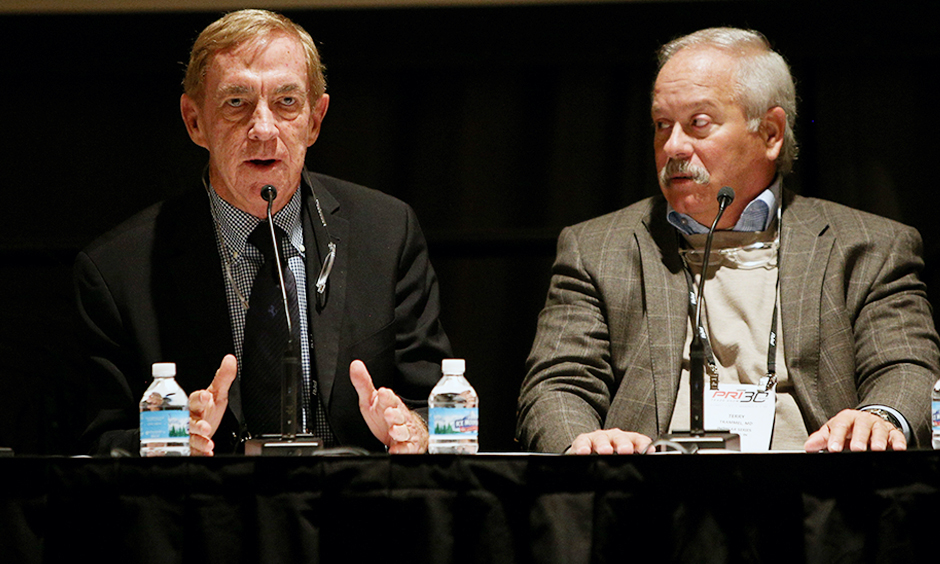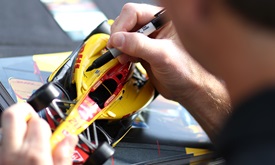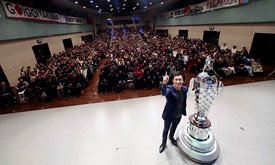INDYCAR safety team keeps working to put itself 'out of business'
DEC 17, 2017
They’ve committed so much of their lives to making significant advancements in racing safety, when a Verizon IndyCar Series driver is injured today, the sport’s foremost safety specialists take it personally.
A panel discussion of experts at the recent Performance Racing Industry Trade Show in Indianapolis included Dr. Terry Trammell recalling his reaction to Sebastien Bourdais suffering hip, pelvis and rib fractures in an Indianapolis 500 qualifying crash last May.
“I was pretty mad,” said Trammell (shown above right), an Indianapolis orthopedic surgeon who has been a pioneer for more than three decades in treating racing injuries. “We did all this work and it didn’t work.”
Jeff Horton, INDYCAR’s director of engineering/safety, reassured his colleague.
“Of course it worked,” Horton said. “He didn’t die.”
Bourdais, a four-time Indy car series champion, recovered and returned for Dale Coyne Racing three months later for the final three races of the 2017 season.
The panel discussed the evolution of racing safety after a presentation of “Yellow, Yellow, Yellow: The INDYCAR Safety Team,” a 45-minute documentary that aired earlier this year on NBCSN examining the unparalleled work of INDYCAR’s Holmatro Safety Team. Ironically, the team is working to make itself obsolete with every safety advancement it makes.
“I think a lot of people are surprised when they see what we do in INDYCAR, but we’ve been doing it for a long time,” Horton said. “As I said in the movie, ‘We’re trying to put ourselves out of business.’”
Trammell and Horton were joined on the panel by Dr. Stephen Olvey, who specializes in neuro-critical care motorsports medicine. An adaptation of Olvey’s book, “Rapid Response: My inside story as a motor racing life-saver,” is the basis for another documentary by Mile A Way Productions, which made “Yellow, Yellow, Yellow.” A “Rapid Response” trailer, which previews the roots of motorsports safety from Olvey’s experiences as one of the founders of the safety team in Indy car racing, was shown at the end of the panel discussion.
Joined also by Mike Yates, retired INDYCAR manager of track safety operations, the panel’s mission has been a continual challenge to learn from the past in providing a safer future.
Horton remembered starting with just tape measures and cameras when they looked more extensively at incidents a couple days after the 1992 Indianapolis 500. Olvey recalled how in an initial 1992 sled test in Warren, Michigan, the crash test dummy’s head went “flying across the room.”
Trammell’s history with saving drivers goes back a decade earlier. He was assigned to the IU Health Methodist Hospital emergency room in Indianapolis in 1981 when racer Danny Ongais was brought in with compound fractures to both legs sustained in a crash on the Indianapolis Motor Speedway oval. The standard prognosis was amputation, but Trammell saved the legs and Ongais raced again.
The physician recalled the cars back then and said, “There was zero driver protection. The helmet was pretty much it.”
Olvey called Trammell after Rick Mears suffered multiple fractures in both feet and ankles in a 1985 crash at Sanair in Canada. The initial diagnosis was to amputate both legs below the knee, Olvey said.
But he summoned Trammell, who flew in on Roger Penske’s personal jet, and saved both legs. Mears continued his career and won two more Indianapolis 500s to become one of just three four-time winners.
Today, crash sites, cars and even the drivers generate data that is analyzed within minutes after an incident. That information has driven the creation of safer cars and equipment. The innovations include drivers wearing accelerometers in their radio earpieces so the effect of crashes on their heads can be analyzed in much the same way a car is thoroughly investigated.
“It just occurred to me one day,” Olvey (shown above left) said, “that if you could make accelerometers small enough that they would fit into the earpieces that drivers wear, and all the crashes we had seen where the helmet had stayed on the earplugs had never been dislodged, if you could keep them with the accelerometers, we could measure what happens to the head just like we measure what happens to the car.
“We were able through the years to get it to the way it is now, which is quite sophisticated.”
As the “Yellow, Yellow, Yellow” documentary showed, the evolution of the Holmatro Safety Team with its doctors, nurses, paramedics and firefighter/EMTs on site for every Verizon IndyCar Series event is credited with other life-saving reactions.
The documentary profiled when James Hinchcliffe hit the wall in a scary 2015 Indianapolis 500 practice crash. Hinchcliffe reiterated his praise in the film for the team that saved his life after a suspension rod penetrated his thigh and pelvis. Hinchcliffe recovered and won the pole for the 2016 Indianapolis 500 presented by PennGrade Motor Oil.
The commitment to safety works both ways, the panel reminded, from ensuring that a helmet properly fits to racers wearing the best firesuits. Trammell and Olvey reiterated that drivers and race teams must be responsible about being educated on utilizing the most recent safety equipment.
If not, Trammell has been known to “get in the face” of a driver.
“Yeah, the drivers love me, like their mother,” Trammell said, smiling.



















